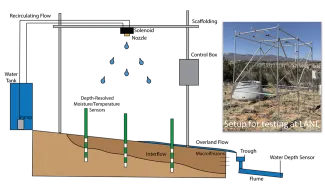The NGEE Arctic Rainfall Simulator (NARS) was designed, built, and tested and is now being deployed to the Seward Peninsula of Alaska.
NGEE Arctic researchers at Los Alamos National Laboratory have developed a rainfall simulator to study permafrost landscape hydro-thermal response to discrete rainfall events. NARS imitates the droplet kinetic energy and size and of natural rainfall and can replicate rainfall intensities between 4 and 80 mm∙h-1 in 10 s increments. The simulator plot size is approximately 2 × 3 m, and the current tank configuration allows for total rainfalls of up to 30 cm in a single event. Surface runoff is collected in a specially designed flume that can record discharge to a precision of ~ 1 mL∙s-1 , every second. NARS will be used to improve our understanding of rainfall-runoff generation mechanisms (e.g., contributions of new water vs. old water) in permafrost landscapes with various landcovers and will improve hillslope hydro-thermal process representation in ATS and ELM; ATS model simulations were also used in the design of NARS to determine ideal rainfall rates and durations. The NARS team deployed NARS to the Seward Peninsula of Alaska for the first time in September 2022. The first experiments will focus on hydro-thermal differences between different landcovers (vegetation), microtopographies (tussocks), and recently burned versus unburned tundra


